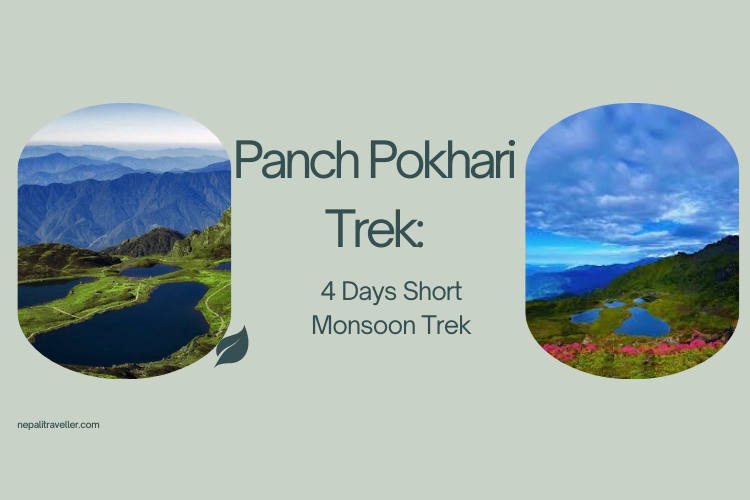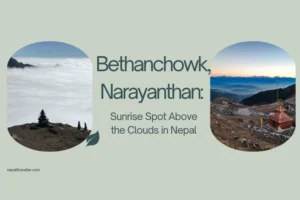Nepal, with its breathtaking natural beauty and rich heritage, offers some of the most thrilling trekking experiences in the world. One of its best-kept secrets is the enchanting 4 Days Panch Pokhari Monsoon Trek, an interesting trek that offers a fascinating journey through dense rhododendron forests, historic Tamang and Sherpa villages, spectacular mountain vistas, and serene sacred lakes. This trek starts in the capital city Kathmandu and goes through villages like Chhimti and Nosyampati and finally reaches the spiritual ambiance of Panch Pokhari — a chain of five sacred lakes way up in the Sindhupalchok district.
At The Trek, we map out the whole 4-day Panch Pokhari Monsoon trek, covering the trail, daily itineraries, key attractions, and advice to guide you in planning this off-season monsoon trek.
Table of Contents
ToggleOverview of the Panch Pokhari Trek
- Duration: 4 Days
- Beginning Point: Kathmandu (KTM)
- Ending Point: Panch Pokhari (Five Sacred Lakes)
- Altitude Range: 1,400 meters (beginning point) to 4,100 meters (Panch Pokhari)
- Difficulty in Trekking: Moderate (several steep ascents, but manageable for trekkers with average fitness)
- Best Time: Monsoon season (June to August) for unique greenery and blooming flora; also post-monsoon (September to November) for clear visibility
Why Go for the Panch Pokhari Trek During Monsoon?
Many will shun monsoon trekking with fears of relentless rains, sloppy trails, and slippery terrain. However, Panch Pokhari trek during monsoon uncovers a magical beauty:
- Lush Greenery: The landscape is fully draped in a lush green cloak with rhododendrons, orchids, and wildflowers in bloom.
- Fewer Tourists: Low tourist traffic during monsoon means more solitude, peacefulness, and unspoiled nature.
- Waterfalls and Streams: Rains revive a number of streams and waterfalls along the trekking route making wonderful natural wonders.
- Cultural Experience: Venturing off the beaten track to villages like Chhimti and Nosyampati, you get close proximity with local villagers, culture, and daily mountain life.
- Unique Spirituality: Both Hindus and Buddhists consider the lakes of Panch Pokhari holy, so the trek is also an experience of spirituality.
4-Day Panch Pokhari Monsoon Trek Itinerary
Day 1: Kathmandu to Chhimti (Drive) and Trek to Tupi Danda (2,200 m)
Start: Early morning drive from Kathmandu to Chhimti trailhead (approximately 3-4 hours)
Trek: Approximately 6 hours walk from Chhimti to Tupi Danda (2,200 meters)
Highlights:
- Panoramic drive through Melamchi
- Trekking through monsoon rain forest and village habitations
Overnight: Rest in a guesthouse or homestay at Tupi Danda
Day 2: Trek from Tupi Danda to Nosyampati and Onward to Panch Pokhari
Trek: Ascend from Tupi Danda to Nosyampati village, and more trek to Panch Pokhari (approximately 4,100 meters)
Highlights:
- Walking through common villages and alpine meadows
- Scenic views of Langtang and Ganesh Himal mountain ranges
- Experiencing the calmness of the five sacred lakes of Panch Pokhari
Overnight: Camping or lodge stay near Panch Pokhari
Day 3: Explore Panch Pokhari and Back to Chhimti
Activities: Early morning tour of the Panch Pokhari lakes, soaking up the spiritual atmosphere and mountain views
Trek: Trek back downhill to Chhimti (about 6-7 hours)
Highlights:
- Beautiful reflections on the lakes in early morning light
- Return travel by forest paths and villages
Overnight: Guesthouse or homestay at Chhimti
Day 4: Return journey by road to Kathmandu
Transport: Drive about 3-4 hours from Chhimti back to Kathmandu
Activities: Trek recovery; optional Kathmandu sightseeing or shopping if time is available
Arrival: Arrive at Kathmandu early evening or afternoon
What to Look Forward to from the Land and Animals
- Flora: Rhododendron, magnolia, oak, bamboo, ferns, orchids
- Fauna: Langur monkeys, Himalayan black bears (less frequently spotted), pheasants, multi-colored butterflies, and various birds including the Himalayan monal
- Rivers & Waterfalls: Several small creeks, Indrawati River views near the start, and picturesque waterfalls along the route, especially vivid colors during the monsoon season
Essential Gear and Planning Tips for Monsoon Trekking
- Waterproof Gear: A decent rain jacket, rain pants, waterproof backpack covers, and aggressive grip shoes
- Layered Wearing Clothes: Monsoon treks are usually cold in the higher altitudes; bring thermal layers, fast-drying tops, and insulating outerwear
- Trekking Poles: Help in maintaining balance while walking over wet or steep parts of the trail
- Foot Wear: Waterproof trekking shoes recommended to prevent slipping
- Mosquito Repellent: Monsoon conditions may increase bug activity
- First Aid Kit: Blister treatment, altitude sickness medication, and general medications
- Snacks & Water: Energy bars, nuts, and hydrating fluids
- Camera & Binoculars: For taking photos of beautiful scenery and wildlife
- Environmental Consideration: Pack reusable water bottles and keep single-use plastics to a minimum to minimize your trekking impact
Physical Fitness and Health Considerations
Even though the Panch Pokhari trek is not challenging, doing some routine cardiovascular exercise like walking, running, or cycling before the trek is still recommended. Gradual ascent and hydration assist in acclimatization. Having a guide for navigation and safety, especially during the monsoon slippery trails, is recommended.
Cultural Insights: Living with the Locals
Stopping over at villages of Chhimti and Nosyampati permits you to catch a glimpse of authentic Himalayan village life. The Tamang and Sherpa inhabitants there live on farming and animal breeding. Locals often invite visitors in for tea or home dining. Be sure to understand local customs — a creased “Namaste” greeting, traditional dress off the shoes on entering houses, and modest dressing will go a long way.
Monsoon festivals and rituals associated with the sacred Panch Pokhari lakes are the rich cultural background that brings a richness to the overall experience of trekking.
Conclusion
The monsoon-season trek to Panch Pokhari is a rare opportunity to experience the Langtang region in its most vibrant, alive form. From the city streets of Kathmandu to the religious peace of the five sacred lakes, the 4-day trek combines physical challenge, natural beauty, spiritual insight, and cultural richness.
Whether you are a veteran trekker or a die-hard nature lover, this trail rewards you with seclusion surrounded by stunning landscapes, interactions with kind locals, and a profound touch of Nepal’s spiritual heritage.
Frequently Asked Questions (FAQs)
1. Why should the 4 Days Panch Pokhari Monsoon Trek be on your bucket list?
The trek offers a unique blend of stunning natural beauty, vibrant monsoon greenery, and rich cultural experiences. It takes you through lush rhododendron forests, picturesque villages, and culminates at the sacred Panch Pokhari lakes known for their spiritual significance. The monsoon season enhances the scenery with blooming flora, waterfalls, and fewer tourists, providing a peaceful and immersive Himalayan adventure unlike any other.
2. What level of fitness is required for the Panch Pokhari Monsoon trek, and what should I prepare for physically?
The trek is rated moderate difficulty with several steep ascents, making it suitable for trekkers with average fitness levels. It is recommended to engage in cardiovascular exercises like walking, running, or cycling before the trek. Proper acclimatization, hydration, and gradual pacing are essential for a comfortable experience, especially at higher altitudes around 4,100 meters.
3. What essential gear should I bring for trekking in the monsoon season on the Panch Pokhari trail?
For monsoon trekking, waterproof gear is critical, including a quality rain jacket, rain pants, and waterproof backpack covers. Sturdy waterproof trekking shoes with good grip are necessary to handle slippery trails. Layered clothing for warmth, trekking poles for balance, mosquito repellent, and a first aid kit with altitude sickness medication are also highly recommended for a safe and enjoyable trek.


